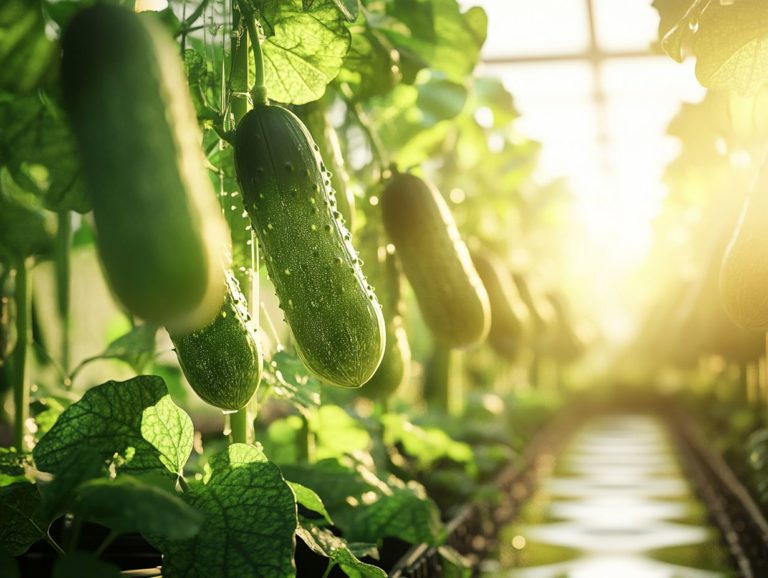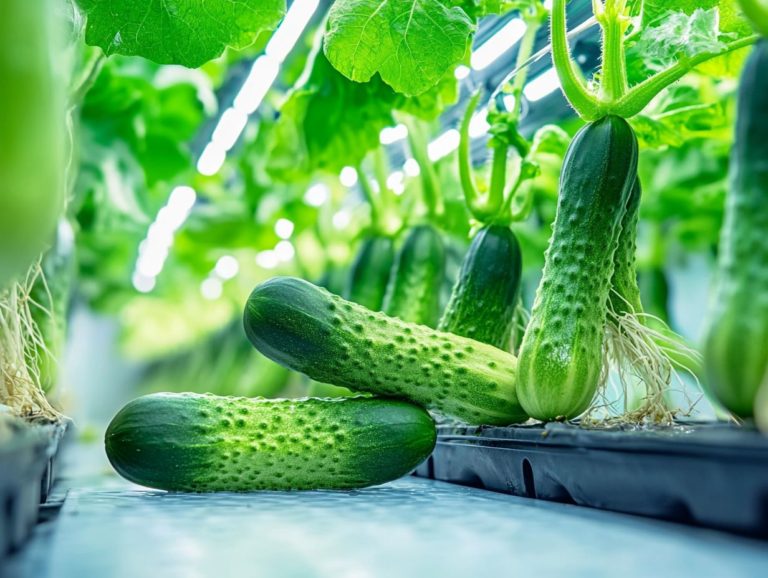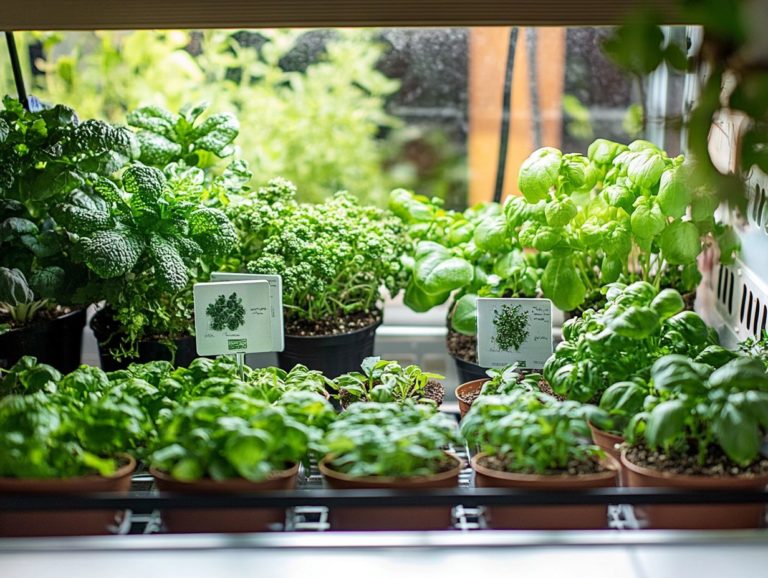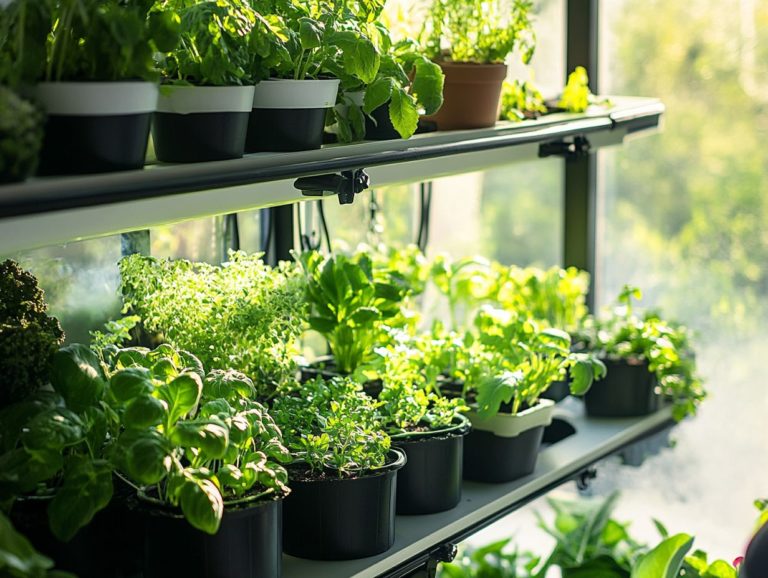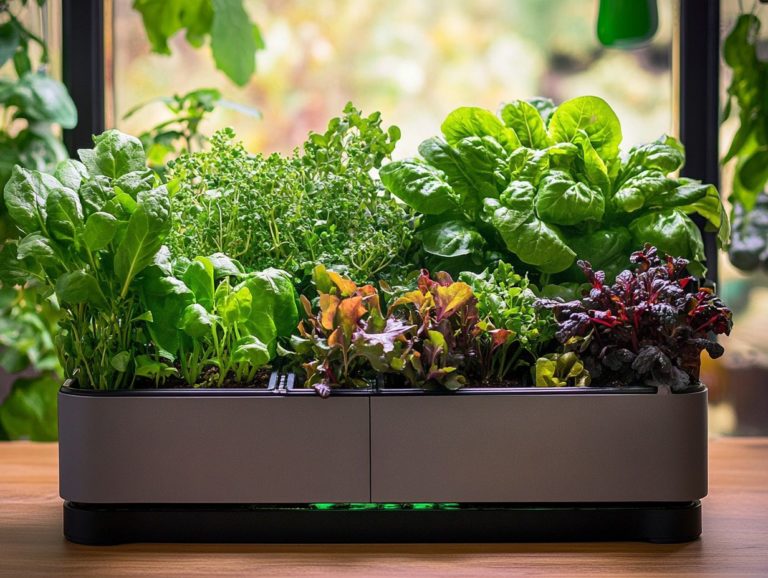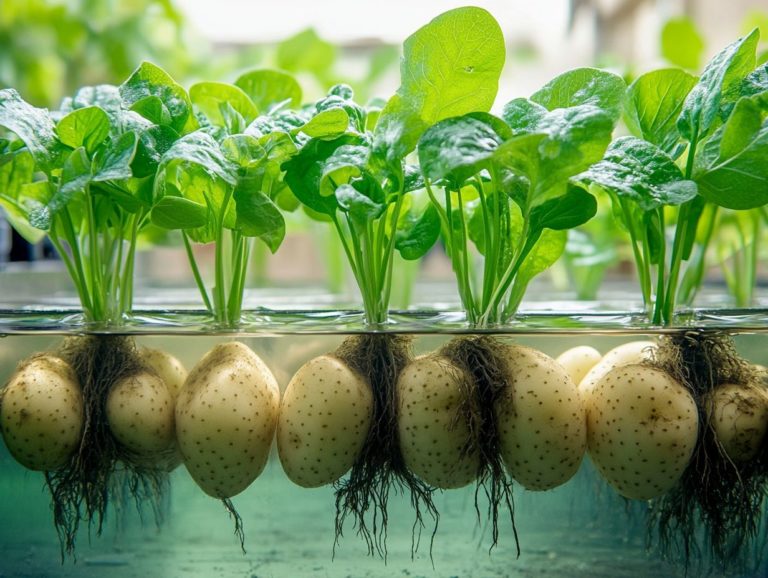“5 Hydroponic Plant Varieties to Try This Year”
Considering a fresh approach to gardening? Hydroponics might be the perfect solution for you! With various hydroponic techniques available, it’s easier than ever to begin your journey in indoor gardening.
This innovative method enables you to cultivate a variety of plants, such as bell peppers and leafy greens, without the need for soil. This makes it ideal for urban settings or anyone with limited space.
You will discover five exciting hydroponic plant varieties, including cherry tomatoes, strawberries, and even some compact varieties. As you explore this gardening style, you will also learn about its myriad benefits.
We will provide tips to help you get started with DIY hydroponic systems. We ll highlight common pitfalls to steer clear of and delve into how hydroponics can contribute to a more sustainable future.
Get ready to transform your indoor space into a thriving garden!
Contents
- Key Takeaways:
- 1. Cherry Tomatoes
- 2. Lettuce
- 3. Strawberries
- 4. Herbs (Basil, Mint, Cilantro)
- 5. Spinach
- Why Choose Hydroponics for Growing Plants?
- What Are the Advantages of Growing Plants Hydroponically?
- What Are the Disadvantages of Hydroponic Gardening?
- How Can One Get Started with Hydroponics?
- What Are the Best Practices for Maintaining a Hydroponic Garden?
- What Are Some Common Mistakes to Avoid in Hydroponic Gardening?
- How Can Hydroponic Gardening Benefit the Environment?
- What Are Some Other Popular Plants to Grow Hydroponically?
- What Are the Future Trends in Hydroponic Gardening?
- How Can Hydroponics Help with Food Security?
- What Are Some Tips for Choosing the Right Hydroponic System for Your Needs?
- How Can One Incorporate Hydroponically Grown Plants into Their Diet?
- Frequently Asked Questions
- What are some hydroponic plant varieties to try this year?
- Why should I try growing hydroponically?
- How do I get started with hydroponic gardening?
- Can I grow these plant varieties in any type of hydroponic system?
- Do I need any special equipment to grow these plant varieties hydroponically?
- Are there any drawbacks to growing plants hydroponically?
Key Takeaways:
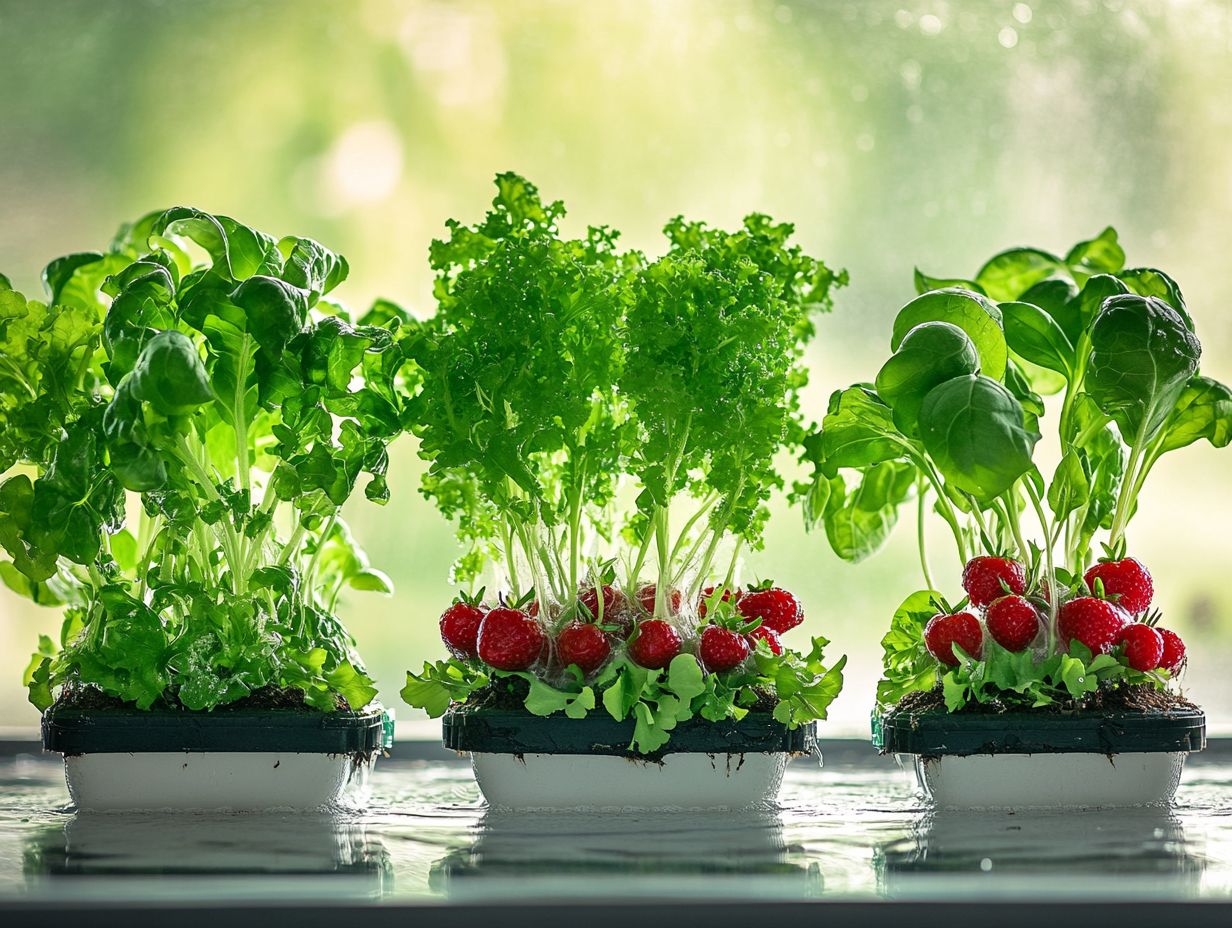
- Try growing cherry tomatoes hydroponically for a year-round supply of fresh, flavorful fruit. Consider adding other plants like spinach and herbs for a diverse kitchen garden.
- Opt for hydroponic lettuce for a faster growth rate and fresher, crisper leaves, making it a rewarding addition to your indoor gardening experience.
- Satisfy your sweet tooth with juicy, plump strawberries grown in a hydroponic system. Explore additional options like growing herbs to enhance your culinary creations.
1. Cherry Tomatoes
Growing cherry tomatoes in a hydroponic system is an exciting venture. You can enjoy fresh, juicy fruits right from the comfort of your indoor space while experimenting with other plant varieties like bell peppers and herbs.
To achieve the best results, pay close attention to key factors. Nutrient-rich water should be rich in potassium, calcium, and magnesium to support robust fruit development.
Ensure a continuous supply of fresh ingredients. Lighting is essential; your cherry tomatoes and other compact plants should bask in at least 12 to 16 hours of bright, full-spectrum light each day to promote healthy growth.
Incorporate care techniques such as regularly monitoring the acidity or alkalinity of the water. Maintain optimal water temperatures and ensure adequate air circulation to enhance your hydroponic garden’s success.
With a bit of diligence, you will soon relish an abundant harvest of sweet cherry tomatoes.
2. Lettuce
Lettuce stands out as one of the simplest and most rewarding crops to grow using hydroponic techniques. It’s an excellent choice for anyone eager to cultivate fresh vegetables and herbs in limited indoor spaces.
With diverse varieties like butterhead, romaine, and leafy greens, as well as herbs like basil and cilantro, you can cater to different taste preferences and culinary applications.
Each type requires specific care, including nutrient-rich water and optimal light exposure. Lettuce generally thrives in temperatures ranging from 60 to 70 degrees Fahrenheit.
To maximize leaf production and guarantee quality, adjust pH levels, maintain optimal humidity, and ensure adequate airflow in your hydroponic system.
Regularly monitoring for pests, diseases, and waterborne diseases will help you prevent potential setbacks and enhance the overall success of your hydroponic garden.
Start growing your indoor garden today!
3. Strawberries
Imagine tasting fresh strawberries right from your garden! Strawberries truly flourish in hydroponic systems, allowing you to savor sweet, homegrown fruits year-round. This method offers the benefits of soil alternatives and efficient nutrient solutions, making it ideal for your smart garden setup.
By using methods like nutrient film technique (where nutrients flow over plant roots without soil) and deep water culture, along with automatic watering systems, your strawberry cultivation can be exceptionally efficient. These plants thrive on a balanced nutrient solution rich in potassium and calcium, essential for promoting healthy growth and bountiful fruit development. They also require appropriate grow lights for optimal results. Maintain a light cycle of 12-16 hours of bright, full-spectrum light to replicate natural sunlight. This will ensure your plants have robust foliage and vibrant blooms.
For effective pollination, gently shake the plants or use a small brush to transfer pollen. This simple action can significantly enhance your fruiting success and overall yield.
4. Herbs (Basil, Mint, Cilantro)
Growing herbs like basil, mint, and cilantro in a hydroponic system is an exceptional way to maintain a steady supply of fresh cooking ingredients. This approach optimizes your indoor gardening space, making it perfect for your kitchen garden.
These herbs thrive in warm temperatures and need six to eight hours of indirect sunlight daily. A well-lit kitchen or balcony becomes the ideal setting for your indoor gardening nook. Basil enjoys a nutrient-rich solution with higher nitrogen content, while mint thrives on a balanced nutrient mix. Cilantro prefers a slightly lower pH, which measures acidity, and moderate nutrient levels to flourish.
For your culinary endeavors, snip these herbs fresh right when you need them. It effortlessly elevates everything from salads to sauces, infusing your home-cooked meals with vibrant flavors from your own garden. Incorporating them into your kitchen garden not only enhances taste but also fosters a deeper connection with the sourcing of your food.
5. Spinach
Spinach is a powerhouse of nutrients. When grown in hydroponic gardens, it offers the chance to cultivate healthy produce indoors, making it a great option for indoor gardening enthusiasts. You can enjoy customized nutrient solutions and ideal growth conditions, making your gardening experience both rewarding and efficient.
To achieve remarkable results, maintain an optimal pH level between 6.0 and 7.0 this measures acidity and supports effective nutrient absorption. Spinach thrives on nitrogen, calcium, and magnesium, which are vital for robust leaf development. By adjusting nutrient concentrations at different growth stages, you can unlock superior outcomes and ensure a continuous supply of fresh vegetables.
When it s time to harvest, remember to pick the outer leaves first. This technique promotes continuous production, allowing the inner foliage to flourish and ensuring you have a steady supply of fresh spinach throughout the season.
Start your hydroponic journey today and enjoy fresh, flavorful produce all year round!
Why Choose Hydroponics for Growing Plants?
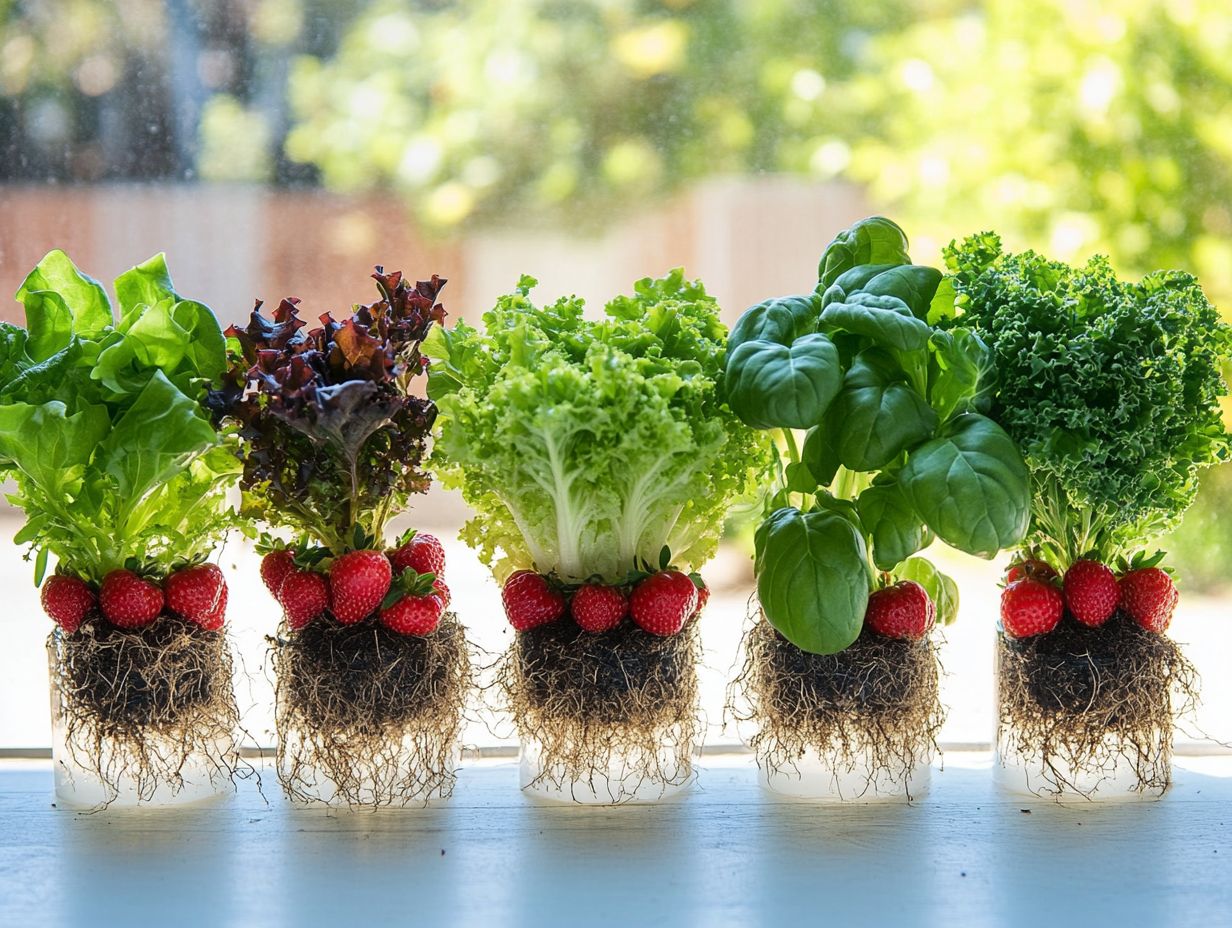
Hydroponics is a new way to grow plants without soil. This method gives you precise control over the nutrient mix, saves space, and allows you to grow in almost any location.
It boosts efficiency, increases yields, and uses far less water than traditional farming. By recycling water, it reduces waste and leads to faster plant growth, giving you quicker harvests and a steady supply of fresh produce all year.
With hydroponic systems, you can cultivate a wide variety of plants, from leafy greens to fruits like strawberries and tomatoes. This means fresh produce is always available, meeting consumer demands and supporting sustainability in food production.
What Are the Advantages of Growing Plants Hydroponically?
The benefits of hydroponic gardening are impressive. You ll enjoy faster plant growth, reduced space requirements, and a continuous supply of fresh vegetables and herbs all year round, making it a great choice for home gardening.
Hydroponics excels at pest control. The controlled environment reduces the need for chemical pesticides, leading to healthier crops and a more eco-friendly approach.
This method also uses significantly less water than soil-based gardening, enhancing its appeal for eco-conscious growers. You can experiment with various plant species, making hydroponics a popular choice for both commercial growers and passionate hobbyists.
What Are the Disadvantages of Hydroponic Gardening?
While hydroponic gardening has many advantages, it also has some drawbacks. Initial setup costs can be higher, and you need some technical knowledge to maintain the right nutrient solutions and pH levels.
Be prepared for potential equipment failures that could affect your crops if not addressed quickly. This reliance on technology can add complexity system malfunctions or power outages might create problems for your plants.
The steep learning curve related to water chemistry and nutrient ratios can be overwhelming for beginners. It takes time and patience to master these essential aspects of hydroponics.
All of these factors can transform what seems like a simple gardening method into a complex endeavor that requires careful planning and ongoing management, especially if you want to expand to a full kitchen garden.
How Can One Get Started with Hydroponics?
Getting started with hydroponics is an exhilarating journey for any aspiring gardener. With a variety of DIY hydroponic systems available, you will discover options tailored to meet your indoor gardening needs and budget. This makes it accessible for anyone eager to dive into soilless cultivation and explore the world of hydroponics.
Now, let’s choose exciting plants like vibrant lettuce and fragrant herbs that thrive! A few essential steps will pave the way for your success. First, selecting the right hydroponic equipment is crucial. Consider what suits your space and the types of plants you wish to grow. You might opt for a simple Kratky system or delve into the complexities of NFT (Nutrient Film Technique), where a thin film of nutrient solution flows over the roots of plants, or aeroponics, where plants are grown in an air or mist environment.
Once your equipment is set up, paying meticulous attention to the initial care of your seedlings is vital. Manage light, water, and nutrient solution to establish a strong foundation for lush growth in this innovative growing method.
What Are the Best Practices for Maintaining a Hydroponic Garden?
Maintaining a hydroponic garden effectively demands attention to best practices. Regularly check nutrient solutions, ensure optimal light conditions, and implement automatic watering systems to encourage flourishing plant growth.
Regularly checking your nutrient levels is crucial to prevent deficiencies that could lead to stunted growth or plant stress. You should also devise a systematic plan for observing waterborne diseases and common plant diseases; early detection and intervention can be the difference between saving your crop and watching it suffer.
Integrating routine maintenance checks is equally important. This allows you to sustain system efficiency and make timely adjustments that address the evolving needs of your plants. By emphasizing these strategies, you enhance the health and productivity of your garden while creating a more rewarding and sustainable growing experience.
What Are Some Common Mistakes to Avoid in Hydroponic Gardening?
Common mistakes in hydroponic gardening can significantly hinder your plant growth and yield. Neglecting to monitor pH levels, over or underfeeding with nutrient solutions, and providing insufficient lighting can all compromise the success of your indoor garden.
Don t wait! Regularly monitor your pH levels, ideally keeping them between 5.5 and 6.5 for most plants. Understanding the specific nutrient requirements of your crops will help you avoid both deficiencies and excesses. Using a balanced nutrient solution tailored to each growth stage can greatly enhance your outcomes in growing plants.
Ensuring that your plants receive adequate light is crucial typically 12 to 16 hours a day for most varieties this can prevent stunted growth and improve photosynthesis. Utilizing grow lights effectively will further enhance this process. By implementing regular checks and adjustments, you ll cultivate a thriving hydroponic system that flourishes beautifully.
How Can Hydroponic Gardening Benefit the Environment?
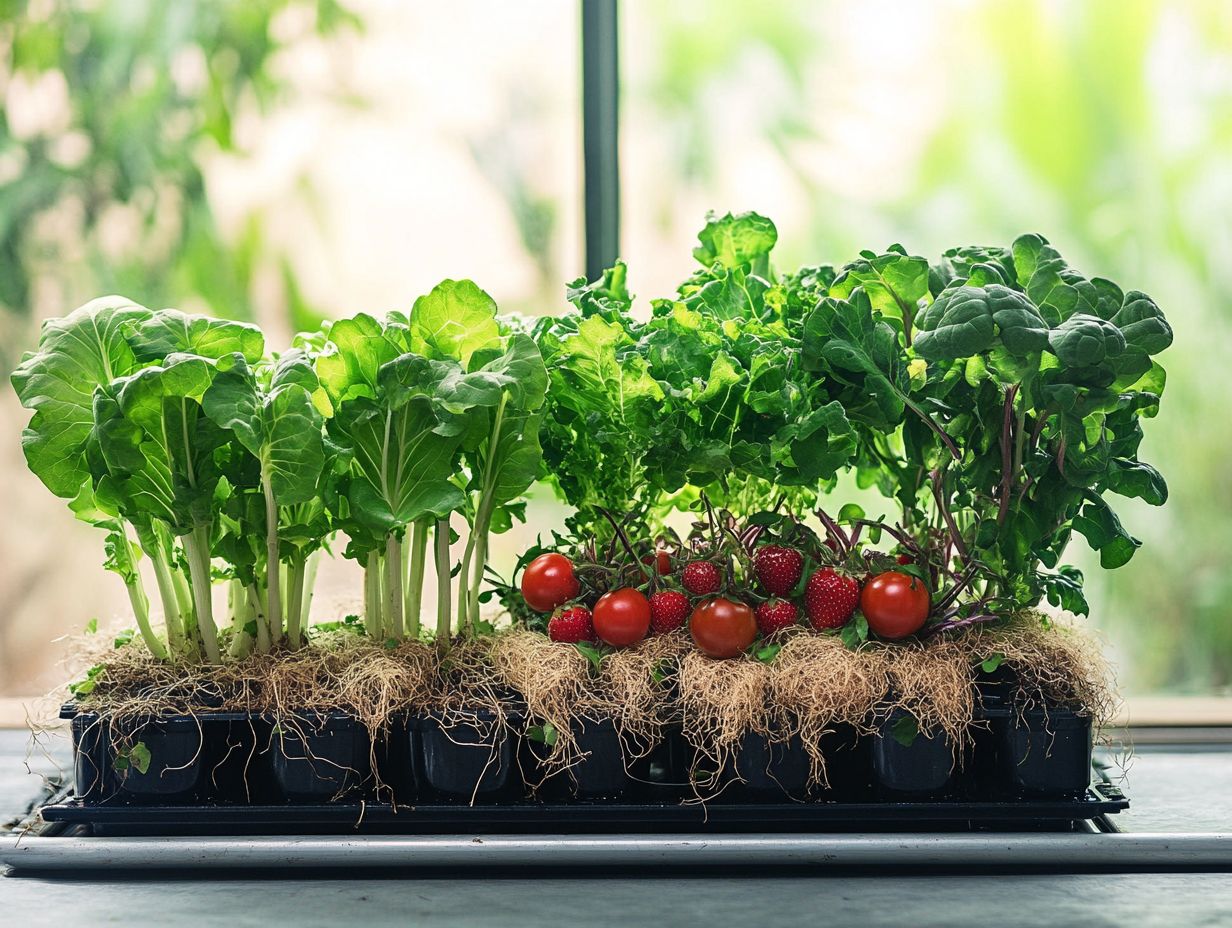
Hydroponic gardening offers remarkable environmental benefits. It significantly reduces water usage compared to traditional soil gardening.
You’ll also minimize reliance on pesticides and promote local food initiatives. This includes exciting DIY hydroponic projects!
By using nutrient-rich solutions instead of soil, you can save up to 90% more water. This is crucial for regions facing chronic water shortages.
With hydroponics thriving in urban areas, you can cut down on transportation-related carbon emissions. This encourages community involvement through local food projects that provide fresh vegetables and cooking ingredients.
This innovative approach supports sustainable urban agriculture. Cities can cultivate fresh produce while conserving valuable resources.
Embracing hydroponic methods is key to tackling food security challenges. It fosters resilient, eco-friendly urban environments.
What Are Some Other Popular Plants to Grow Hydroponically?
Many popular plants thrive in hydroponic systems. Along with lettuce and strawberries, you can grow tomatoes, bell peppers, and herbs like basil, cilantro, and parsley.
Basil is particularly great in these systems, offering aromatic leaves that enhance your culinary creations. Cucumbers also grow well but need careful attention to nutrients and humidity for optimal growth.
If you want color indoors, try growing edible flowers like geraniums or impatiens in hydroponics. With the right light and nutrient conditions, these plants can yield bountiful harvests.
What Are the Future Trends in Hydroponic Gardening?
The future of hydroponic gardening looks bright! Emerging trends like smart garden technologies, vertical farming, and increased automation will change how you grow plants indoors.
As more people discover the benefits of soil-less cultivation, adoption rates are rising. Urban dwellers are eager for fresh vegetables.
Innovative systems, like app-controlled nutrient delivery and self-monitoring environments, are becoming standard. This helps even novice gardeners succeed.
This shift simplifies home farming and builds community among gardening enthusiasts. These advancements are reshaping food production, making sustainable, local food sources more accessible.
How Can Hydroponics Help with Food Security?
Hydroponics is an exciting way to grow food. It plays an important part in enhancing food security by enabling you to grow fresh vegetables like bell peppers and herbs locally, no matter the environmental challenges.
This approach not only promotes sustainable practices but also reduces your dependence on long-distance food transportation.
With hydroponics, urban areas often distant from traditional farming can grow plants in controlled settings. This makes fresh produce readily accessible to city dwellers like you.
By focusing farming efforts in urban settings, this method significantly lowers the carbon footprint linked to transporting food over vast distances. It also maximizes yields by making efficient use of space, potentially increasing your daily access to nutritious options.
These advancements not only tackle immediate food shortages but also align beautifully with global food security initiatives and gardening challenges. They support local economies and enable communities to take control of their food sources, fostering a sense of ownership and resilience.
What Are Some Tips for Choosing the Right Hydroponic System for Your Needs?
Choosing the right hydroponic system depends on your indoor space and the plants you want to grow. Features like automatic watering can make your gardening experience easier.
It s essential to evaluate long-term sustainability, ease of maintenance, and the costs associated with initial investment for indoor gardening. Different systems come with varying levels of complexity, so understanding how much time and resources you re willing to commit is crucial.
If you re interested in cultivating a diverse range of plants, modular setups may provide the flexibility you desire. Alternatively, you might lean towards aquaponics, a method that combines fish farming with growing plants, for the added benefit of a continuous supply of nutrient-rich solutions.
By examining these aspects closely, you can make a more informed choice that not only meets your current needs but also evolves alongside your gardening journey.
How Can One Incorporate Hydroponically Grown Plants into Their Diet?
Incorporating hydroponically grown plants into your diet elevates your meals with fresh cooking ingredients and fosters healthier eating habits. This provides you with access to nutrient-rich vegetables and herbs right from your own kitchen garden.
These vibrant greens can be seamlessly integrated into your salads, adding a delightful crispness and a burst of flavor. You can also blend them into smoothies for a nutritious start to your day.
For dinner, think about saut ing hydroponic herbs like basil or cilantro with seasonal crops to create a captivating stir-fry. You might also sprinkle them as a garnish for soups and stews, infusing your dishes with a touch of freshness.
Opting for locally sourced, hydroponically grown produce reduces your carbon footprint. It ensures that you re nourishing your body while supporting sustainable agricultural practices and community gardens.
This connection to local farming can deepen your appreciation for food and contribute to a healthier community overall.
Frequently Asked Questions
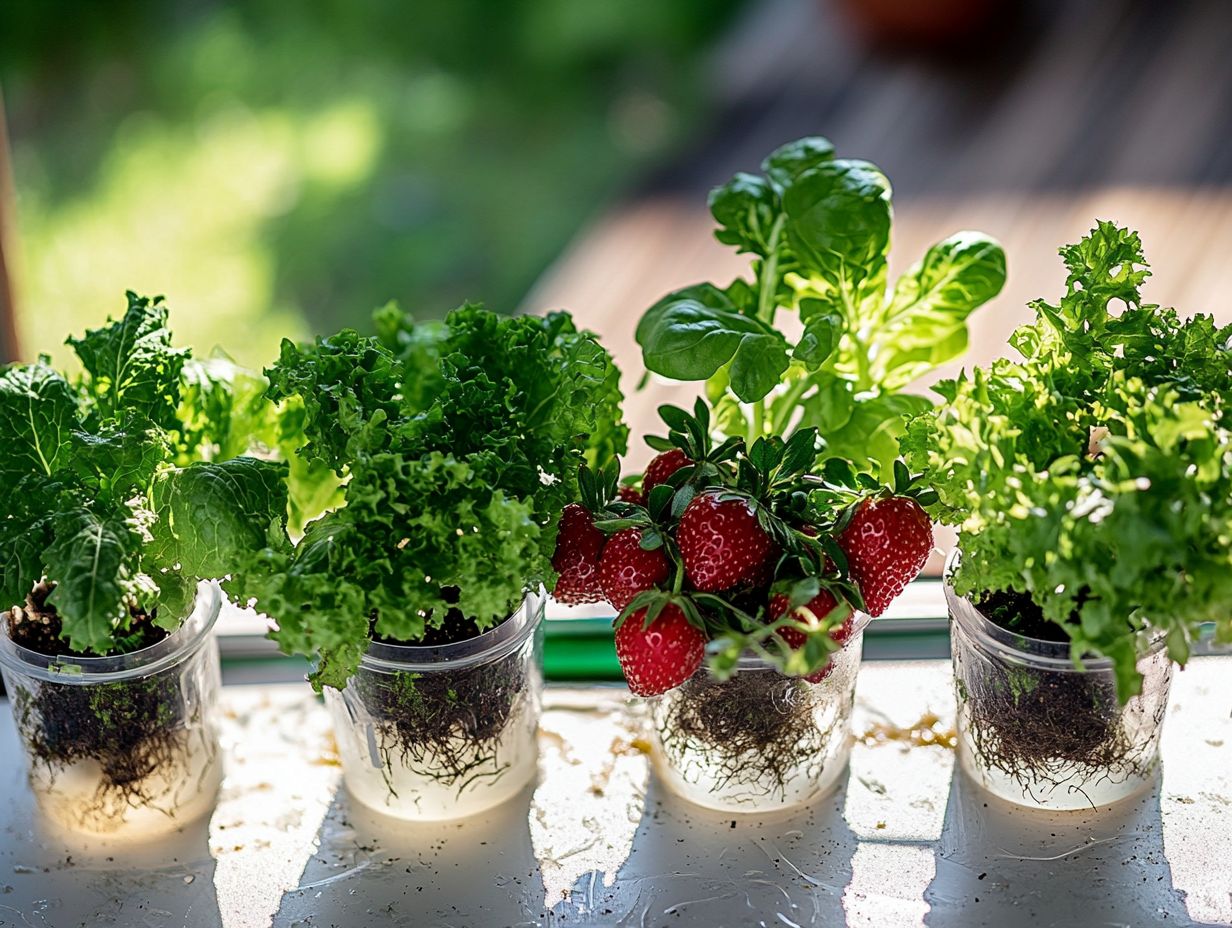
What are some hydroponic plant varieties to try this year?
Some great hydroponic plant varieties to try this year include lettuce, spinach, tomatoes, bell peppers, herbs, and cucumbers.
Why should I try growing hydroponically?
Hydroponic gardening allows for faster growth and higher yields. It uses less water and space and eliminates the need for soil and pesticides, making it an excellent method for producing fresh vegetables and leafy greens.
Ready to grow your own food? Start your hydroponic journey today!
How do I get started with hydroponic gardening?
Start by researching different hydroponic systems. Choose one that fits your needs.
Next, set up a growing area with proper lighting and nutrients. Select plants like lettuce, spinach, and herbs for your system.
Can I grow these plant varieties in any type of hydroponic system?
You can grow lettuce, tomatoes, strawberries, bell peppers, herbs, and cucumbers in various hydroponic systems. These include deep water culture, ebb and flow, and drip systems.
Do I need any special equipment to grow these plant varieties hydroponically?
Many hydroponic systems come with essential equipment. However, you might need extra tools like pH meters, grow lights, and timers.
Are there any drawbacks to growing plants hydroponically?
Although hydroponic gardening offers numerous benefits, it can be more expensive at first. It also requires careful attention to nutrient levels to prevent diseases.

